
- Home
- Travel Packages
- Top Destination
-
Travel Attraction
By Category
Top Attraction

- Travel Agents
- Car Rentals
- Hotels

The Hassan II Mosque is one of the largest mosques in the world, located in Casablanca, Morocco. It is an architectural marvel that stands on the edge of the Atlantic Ocean. With its towering minaret and beautiful intricate details, it has become an iconic landmark in the city and a major attraction for visitors from around the world. The mosque is not only a religious site but also a symbol of Morocco’s rich cultural heritage and artistic excellence. It was completed in 1993, designed by the French architect Michel Pinseau, and is dedicated to the late King Hassan II, who envisioned its construction. How to Reach Hassan II Mosque, Casablanca Casablanca is Morocco's largest city, and the Hassan II Mosque is centrally located on the city’s coastline, making it easy to reach by various means of transportation. By Car: If you're driving in Casablanca, the mosque is easily accessible via the main roads, including Mohammed V Avenue. Parking is available nearby, though it can get busy during peak times, especially on weekends or during religious holidays. By Public Transport: The mosque is well-connected by the city's public transport system. You can take a tram from various parts of the city, including the Hassan II Tram Station, which is not too far from the mosque. By Taxi: Taxis are a popular and convenient mode of transport in Casablanca. You can take a taxi directly to the mosque from anywhere in the city. Just ensure that you agree on the fare or ask for a meter taxi to avoid any confusion. By Walking: If you're staying in the city center, walking to the mosque is a pleasant experience as the surrounding area is very scenic, with views of the ocean and the nearby beach. Weather at Hassan II Mosque, Casablanca Casablanca enjoys a Mediterranean climate, meaning the weather around the Hassan II Mosque is mild throughout the year. The average temperatures range from 12°C (54°F) in winter to 25°C (77°F) in summer, though it can occasionally get hotter in peak summer months. The best time to visit is during the spring (March to May) or fall (September to November), as the temperatures are comfortable for outdoor activities. It is important to note that Casablanca is a coastal city, so wind and humidity levels can vary, especially near the mosque which sits directly by the Atlantic Ocean. Timing of Hassan II Mosque, Casablanca The Hassan II Mosque is open to visitors every day, with specific visiting hours depending on the time of the year and the local religious schedule. The mosque generally opens in the morning and closes around late afternoon. However, it is closed to non-Muslim visitors during prayer times, especially on Fridays, the holy day for Muslims. Guided tours are available and typically take around an hour. It is recommended to check in advance if you're planning to visit during the Ramadan period, as there might be different visiting hours. Why is the Hassan II Mosque Famous? The Hassan II Mosque is famous for several reasons, with its scale, location, and architectural design standing out the most. The mosque's minaret, standing at 210 meters, is the tallest in the world and can be seen from miles around. The mosque is also unique because a part of it is built over the Atlantic Ocean, with an enormous prayer hall that can accommodate over 25,000 worshippers. Its intricate design includes traditional Moroccan craftsmanship combined with modern materials such as marble, wood, and glass. The mosque is one of the few in Morocco that is open to non-Muslim visitors, making it a significant cultural and tourist destination in the country. The grand scale and artistry make it one of the most impressive landmarks in Africa and a symbol of Morocco’s religious and cultural pride. Entry and Visit Details about Hassan II Mosque, Casablanca The Hassan II Mosque is open to tourists, but there are specific entry rules and regulations. Non-Muslim visitors are allowed to explore the mosque’s grand halls, gardens, and prayer areas, but they must be accompanied by a guide. It is important to dress modestly when visiting the mosque. Women should cover their shoulders, arms, and legs, while men should avoid wearing shorts. The guided tours provide insightful information about the mosque’s history, architectural features, and significance in Moroccan culture. The mosque also features a small museum that houses historical artifacts and exhibits about Islam and Moroccan traditions. Visitors can also enjoy the stunning views of the Atlantic Ocean from the mosque’s terraces. The entry fee for the mosque is typically around 120 MAD (Moroccan Dirhams), though prices may vary depending on the season or group bookings. History and Architecture of Hassan II Mosque The Hassan II Mosque has a fascinating history and is a testament to the vision of King Hassan II, who wanted to build a grand mosque to honor Islam’s teachings and showcase Morocco’s architectural brilliance. Construction began in 1986 and was completed in 1993, taking around seven years to build. The mosque was constructed on a man-made platform that juts into the Atlantic Ocean, a location chosen to symbolize the connection between Morocco and the ocean. Architecturally, the mosque blends traditional Moroccan design with modern materials. It features intricate mosaics, marble floors, carved woodwork, and stunning calligraphy. The minaret, which is the tallest in the world, has a laser beam at its top that points toward Mecca. The mosque’s roof is retractable, allowing it to open during favorable weather conditions. The mosque’s spacious interior can accommodate 25,000 worshippers, while an additional 80,000 can gather outside in the mosque's courtyards. Things to Do Around Hassan II Mosque While visiting the mosque is a must, there are plenty of other activities you can enjoy in the area: Visit the Corniche: Just a short walk from the mosque, the Corniche is a beautiful coastal area with beaches, restaurants, and cafes where you can relax by the ocean. Explore the Medina: A few miles away is Casablanca's historic Medina, where you can experience the vibrant markets and shops offering Moroccan goods such as textiles, spices, and pottery. Royal Palace of Casablanca: Another notable attraction in the city, this palace showcases traditional Moroccan architecture and is an important cultural landmark. Interesting Facts and Tips about Hassan II Mosque Fact 1: The mosque's minaret is so tall that it is visible from nearly 30 kilometers away. Fact 2: The mosque was built using materials from all over Morocco, including marble from the Atlas Mountains and wood from the Rif Mountains. Tip 1: Arrive early to avoid the crowds and enjoy a peaceful visit. Tip 2: Dress modestly and respectfully, as it is a place of worship. Tip 3: Take a guided tour to learn more about the intricate details of the mosque and its history.
Explore More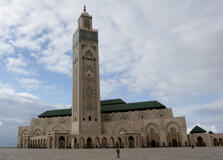
Al Quds Mosque is one of the notable mosques in Casablanca, Morocco. It serves as a place of worship and a center for religious and cultural activities. Known for its stunning architecture and spiritual significance, the mosque is a peaceful sanctuary in the heart of the bustling city. How to Reach Al Quds Mosque, Casablanca The mosque is located in a well-connected area of Casablanca, making it easy to reach by various means of transportation: By Air: Mohammed V International Airport is about 30 km away. Taxis and airport shuttles provide direct access to the city. By Train: The nearest major train stations, Casa Port and Casa Voyageurs, offer convenient connections. By Tram: The Casablanca tramway has stops near the mosque, making it a budget-friendly transportation option. By Taxi: Taxis are widely available and provide a quick and comfortable ride to the mosque. Weather in Casablanca Casablanca enjoys a Mediterranean climate with mild winters and warm summers. The best time to visit is between March and May or September and November when the weather is pleasant for sightseeing. Timings of Al Quds Mosque The mosque follows traditional prayer times, which vary slightly throughout the year. Visitors should be aware of the following: Open daily for prayers. Non-Muslim visitors may not be permitted inside during prayer hours. Fridays and religious holidays see larger crowds. Why is Al Quds Mosque Famous? Al Quds Mosque is renowned for several reasons: Its elegant Islamic architecture with intricate designs. It serves as a key religious and community center in Casablanca. A peaceful place for worshippers and those seeking spiritual solace. Entry and Visit Details Entry is generally restricted to Muslims, as with most mosques in Morocco. Modest clothing is required, and visitors should observe respectful behavior while near the mosque. History and Architecture Al Quds Mosque is an example of traditional Moroccan Islamic architecture, featuring ornate geometric patterns, beautiful calligraphy, and a spacious prayer hall. It reflects the rich cultural heritage of Morocco and its deep-rooted Islamic traditions. Things to Do at Al Quds Mosque Admire the mosque’s stunning exterior and architectural details. Experience the spiritual atmosphere during prayer times. Visit nearby local markets and cultural sites. Capture beautiful photographs of the mosque’s façade. Facts and Tips about Al Quds Mosque The mosque is named after Al-Quds (Jerusalem), a city of great religious significance. Fridays are the busiest days due to congregational prayers. It is recommended to visit in the morning or late afternoon for a peaceful experience. Women should wear modest clothing, and men should avoid shorts when visiting religious sites.
Explore More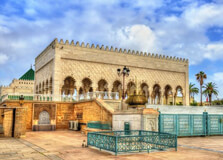
The Mausoleum of Mohammed V is one of the most significant historical landmarks in Rabat, Morocco. It serves as the final resting place of King Mohammed V, the father of Moroccan independence, along with his sons, King Hassan II and Prince Abdallah. This grand structure stands as a tribute to the legacy of Morocco’s royal family and showcases the country’s rich architectural heritage. How to Reach Mausoleum of Mohammed V, Rabat The Mausoleum of Mohammed V is centrally located in Rabat, making it easily accessible by various modes of transportation: By Air: The nearest airport is Rabat-Salé Airport, about 10 km away. Taxis and rental cars are available for transportation. By Train: The Rabat Ville train station is well connected to other Moroccan cities, with taxis and buses available to take visitors to the mausoleum. By Bus: Public buses operate throughout the city and stop near the Hassan Tower, which is adjacent to the mausoleum. By Taxi: Taxis are a convenient and affordable option to reach the mausoleum. Weather in Rabat Rabat enjoys a Mediterranean climate, with mild winters and warm summers. The best time to visit is during spring (March to May) and autumn (September to November) when the weather is pleasant for sightseeing. Timings of Mausoleum of Mohammed V The mausoleum is open to visitors during the following hours: Monday to Sunday: 8 AM - 6 PM Closed on religious holidays and certain special occasions. Why is the Mausoleum of Mohammed V Famous? The Mausoleum of Mohammed V is renowned for several reasons: It houses the tombs of King Mohammed V, King Hassan II, and Prince Abdallah. Its stunning traditional Moroccan architecture makes it a must-visit landmark. It stands opposite the iconic Hassan Tower, creating a picturesque historical site. The mausoleum reflects Morocco’s independence and the legacy of its royal family. Entry and Visit Details Visitors can explore the mausoleum free of charge. As it is a religious site, respectful behavior and modest attire are required. Non-Muslims are allowed to visit, unlike many other mausoleums in Morocco. History and Architecture Commissioned in 1962, the Mausoleum of Mohammed V was completed in 1971. It is a prime example of traditional Moroccan craftsmanship, featuring white marble walls, a green tiled roof symbolizing Islam, and intricate calligraphy and mosaics inside. The tomb chamber is guarded by ceremonial royal guards, adding to its grandeur. Things to Do at Mausoleum of Mohammed V Admire the magnificent Moroccan architecture and intricate carvings. Pay respects at the tombs of Morocco’s late kings. Capture stunning photographs of the mausoleum and the adjacent Hassan Tower. Observe the royal guards and their traditional uniforms. Facts and Tips about Mausoleum of Mohammed V The mausoleum is one of the few religious sites in Morocco open to non-Muslims. It is considered a masterpiece of modern Alaouite dynasty architecture. Early morning and late afternoon visits provide the best lighting for photography. Visitors should dress modestly as a sign of respect for the site’s religious importance.
Explore More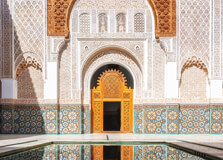
Medersa Ben Youssef is one of the most remarkable historical sites in Marrakech, Morocco. This former Islamic school is renowned for its stunning architecture, intricate tilework, and rich history. Established in the 14th century, it was once the largest and most prestigious theological college in North Africa, attracting students from across the region. How to Reach Medersa Ben Youssef, Marrakech Medersa Ben Youssef is located in the heart of Marrakech's Medina, making it easily accessible from various points in the city. By Air: The nearest airport is Marrakech Menara Airport (RAK), approximately 6 km from the Medina. By Taxi: You can take a taxi to the Medina and walk through the narrow streets to reach the Medersa. By Foot: If you're staying in the Medina, it is within walking distance from many major attractions. By Bus: Public buses and tourist buses stop near the Medina, from where you can walk to the site. Weather in Marrakech Marrakech has a semi-arid climate with hot summers and mild winters. The best time to visit is between March and May or from September to November when the weather is pleasant. Timings of Medersa Ben Youssef The site is open to visitors daily with the following schedule: Monday to Sunday: 9:00 AM - 6:00 PM Last admission: 5:30 PM It is advisable to visit in the morning to avoid crowds. Why is Medersa Ben Youssef Famous? Medersa Ben Youssef is famous for: Being the largest Islamic school in Morocco. Its stunning Moorish architecture with intricate zellij tilework and wooden carvings. The beautiful central courtyard surrounded by student rooms. A peaceful and serene atmosphere despite being located in the bustling Medina. Entry and Visit Details Entry Fees: Adults: 50 MAD Children under 12: Free Tickets can be purchased at the entrance or online. History and Architecture Medersa Ben Youssef was originally built in the 14th century and later renovated in the 16th century under the Saadian dynasty. The school was designed to house up to 900 students studying the Quran and Islamic teachings. The architecture is a blend of Andalusian and Moorish styles, featuring an ornate courtyard, wooden latticework, and colorful mosaics. The inscription above the entrance reads, "You who enter my door, may your highest hopes be exceeded." Things to Do at Medersa Ben Youssef Explore the stunning central courtyard with its marble floors and zellij tilework. Visit the student rooms to get a glimpse of life in an Islamic school. Admire the intricate stucco and cedarwood carvings. Take photographs of the breathtaking architecture. Learn about the history of Islamic education in Morocco. Facts and Tips about Medersa Ben Youssef The Medersa was fully restored and reopened to visitors in 2022. It was once home to over 900 students at its peak. The building features more than 100 tiny dormitory rooms. Visit early in the morning or late in the afternoon to avoid large crowds. Hiring a guide can enhance your understanding of the site’s history.
Explore More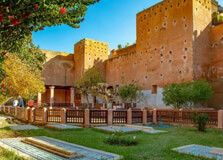
The Saadian Tombs in Marrakech are a historical landmark that dates back to the late 16th century. These tombs are the final resting place of members of the Saadian dynasty, including Sultan Ahmad al-Mansur. The tombs remained hidden for centuries before being rediscovered in 1917. Today, they are one of Marrakech’s most visited attractions, known for their intricate decorations and historical significance. How to Reach Saadian Tombs, Marrakech The Saadian Tombs are located near the Kasbah Mosque in the southern part of the Medina. By Air: The nearest airport is Marrakech Menara Airport (RAK), about 5 km away. By Taxi: Taxis are available throughout Marrakech and can take you directly to the site. By Foot: If you are in the Medina, it is a short walk from Jemaa el-Fnaa. By Bus: Several local buses and tour buses stop near the Kasbah area. Weather in Marrakech Marrakech has a warm climate with hot summers and mild winters. The best time to visit is from March to May or September to November when the weather is pleasant. Timings of Saadian Tombs The tombs are open daily with the following schedule: Monday to Sunday: 9:00 AM - 5:00 PM Last entry: 4:30 PM Visiting early in the morning is recommended to avoid crowds. Why Are the Saadian Tombs Famous? The Saadian Tombs are famous for: Their historical importance as the burial site of the Saadian royal family. The exquisite architectural and decorative details. Their rediscovery in 1917, making them one of Marrakech’s hidden gems. Entry and Visit Details Entry Fees: Adults: 70 MAD Children under 12: Free Tickets can be purchased at the entrance. History and Architecture The Saadian Tombs were built during the reign of Sultan Ahmad al-Mansur in the late 1500s. They house over 60 members of the Saadian dynasty. The tombs are famous for their intricate carvings, colorful zellij tilework, and detailed cedarwood ceilings. Things to Do at Saadian Tombs Explore the Hall of Twelve Columns, the most beautifully decorated chamber. Admire the intricate Islamic calligraphy and floral motifs. Learn about the history of the Saadian dynasty. Take photographs of the stunning architectural details. Facts and Tips about Saadian Tombs The tombs were sealed off for centuries and rediscovered in 1917. The site is relatively small, so expect a short visit (30-45 minutes). Best visited early in the morning to avoid crowds. Wear comfortable shoes as you may need to stand in line.
Explore More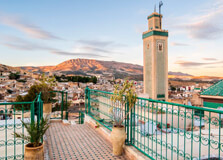
The Quaraouiyine Mosque, also known as the Al-Qarawiyyin Mosque, is one of the most significant religious and historical landmarks in Fes, Morocco. Not only is it a spiritual center for Muslims, but it is also renowned as one of the oldest universities in the world. Founded in 859 AD by Fatima al-Fihri, the mosque and its associated university, Al-Qarawiyyin, have played a pivotal role in the intellectual and cultural history of the Islamic world. With its rich history, stunning architecture, and cultural importance, the Quaraouiyine Mosque attracts visitors from around the globe, making it a must-visit destination for anyone exploring Fes. How to Reach Quaraouiyine Mosque, Fes The Quaraouiyine Mosque is located in the heart of the Fes el-Bali (Old Fes) medina, making it accessible to tourists exploring the ancient streets of the city. Since the mosque is situated within the labyrinthine alleyways of the medina, it is best to ask locals for directions if you are unfamiliar with the area. If you're staying within the medina, you can walk to the mosque, as it is centrally located and within walking distance from many hotels and guesthouses. Alternatively, taxis or private transportation can drop you off near one of the main gates of the medina, from where you can take a short walk. Be prepared for narrow, bustling streets that can be crowded, especially during peak hours. Weather at Quaraouiyine Mosque, Fes Fes experiences a Mediterranean climate with hot, dry summers and mild winters. The best time to visit the Quaraouiyine Mosque is during the spring (March to May) or autumn (September to November), when the weather is moderate and comfortable for walking around the medina. During these months, temperatures range from 18°C to 25°C (64°F to 77°F). The summer months (June to August) can be very hot, with temperatures often exceeding 35°C (95°F), so it is advisable to visit early in the morning or later in the evening to avoid the intense heat. In winter (December to February), temperatures are cooler, but still relatively mild, with daytime temperatures between 10°C to 18°C (50°F to 64°F). Timing for Visiting Quaraouiyine Mosque, Fes The Quaraouiyine Mosque is a functioning religious site, so it is important to be aware of prayer times when planning your visit. Non-Muslim visitors are not permitted to enter the mosque itself, but they can explore its surrounding courtyards and the Al-Qarawiyyin University, which is adjacent to the mosque. The mosque is generally open to visitors during the day, with hours that may vary depending on religious activities and special events. It is best to visit in the morning or early afternoon, when the surrounding areas are less crowded. If you plan to explore the mosque’s exterior, be respectful of prayer times and avoid visiting during the daily prayers, especially the Friday Jumu'ah prayer, which can be a busy time for worshippers. Why Quaraouiyine Mosque, Fes is Famous The Quaraouiyine Mosque is famous for several reasons. First and foremost, it is one of the oldest and most historically significant religious and educational institutions in the Islamic world. Founded in 859 AD, Al-Qarawiyyin University, which is associated with the mosque, is recognized by UNESCO and the Guinness World Records as the world’s oldest continuously operating degree-granting university. Over the centuries, it has attracted scholars from across the Muslim world and beyond. The mosque is also renowned for its stunning architecture, with intricate tilework, beautiful arches, and a grand courtyard that embodies the best of Moroccan architectural styles. The mosque has served as a hub of learning, science, and culture for over a millennium, making it an essential part of Fes’ rich heritage. Entry and Visit Details about Quaraouiyine Mosque, Fes While the Quaraouiyine Mosque is an essential site in Fes, non-Muslim visitors are not allowed inside the mosque for religious reasons. However, there is still much to appreciate by exploring the surrounding areas. Visitors can enter the courtyard and enjoy the beautiful architecture from the outside, as well as visit the adjoining Al-Qarawiyyin University. The mosque’s exterior features intricate tilework, fountains, and large wooden doors, all of which provide ample opportunities for photography. For those interested in the history of the mosque, it is possible to arrange a guided tour to learn more about its cultural and religious significance. Nearby attractions include the famous Bou Inania Madrasa and various souks (markets) that sell traditional Moroccan goods. History of Quaraouiyine Mosque, Fes The history of the Quaraouiyine Mosque is deeply intertwined with the founding of Al-Qarawiyyin University in 859 AD. The mosque was established by Fatima al-Fihri, a wealthy woman who was passionate about learning and education. She used her inheritance to build the mosque and the university, which was originally designed as a madrasa (Islamic school). Over time, Al-Qarawiyyin grew into a renowned institution of higher learning, attracting scholars from across the Muslim world. Some of the greatest minds in history, such as the philosopher Ibn Rushd (Averroes), studied here. The mosque itself underwent several renovations throughout its history, most notably in the 10th and 14th centuries, with many of its beautiful design elements dating from the Merinid period (13th-14th century). Architecture of Quaraouiyine Mosque, Fes The architecture of the Quaraouiyine Mosque is a stunning example of traditional Moroccan Islamic design. The mosque features an expansive courtyard surrounded by arcades supported by horseshoe arches, with exquisite decorative details in the form of carved stucco, mosaics, and intricate tilework. The green-tiled minaret, one of the most iconic features of the mosque, stands as a symbol of Fes. Inside, the mosque boasts a series of beautifully decorated prayer halls, although non-Muslim visitors are not permitted inside. The overall design of the mosque reflects a fusion of Andalusian, Berber, and Arab architectural influences, making it a significant example of Islamic art and architecture in North Africa. Things to Do at Quaraouiyine Mosque, Fes While you cannot enter the mosque itself, there are still plenty of things to do around the Quaraouiyine Mosque and its surroundings: Explore the Al-Qarawiyyin University: Although you cannot enter the main mosque, you can visit the adjacent university, which is an integral part of the site’s educational heritage. The university still operates today and offers a glimpse into the Islamic educational system. Take a Guided Tour: Hiring a local guide can enrich your experience, providing you with valuable insights into the mosque's history, the importance of Al-Qarawiyyin University, and the architectural beauty of the site. Photography: The mosque’s exterior, with its ornate tilework and grand arches, provides many opportunities for photography. The surrounding medina also offers a vibrant backdrop of daily life in Fes. Visit Nearby Attractions: The mosque is located in close proximity to other historic sites in Fes, such as the Bou Inania Madrasa, the Nejjarine Fountain, and the famous Fes tanneries. Make sure to take time to explore the surrounding area. Facts and Tips About Quaraouiyine Mosque, Fes Fact: Al-Qarawiyyin University, associated with the mosque, is the world’s oldest continuously operating degree-granting university. Tip: Since the mosque is a working religious site, be mindful of prayer times when planning your visit. It’s best to avoid visiting during prayer times, especially on Fridays. Fact: The mosque was founded in 859 AD by Fatima al-Fihri, a woman who invested her inheritance into the project. Tip: Respect the local customs and dress modestly when visiting religious sites in Morocco, including the Quaraouiyine Mosque. Fact: The mosque has been a center of learning for centuries, attracting scholars such as Ibn Rushd (Averroes) and Maimonides. Conclusion The Quaraouiyine Mosque is not just a religious monument; it is a living testament to the intellectual and cultural history of Fes and the wider Islamic world. Its rich history, stunning architecture, and association with one of the oldest universities in the world make it a must-see destination for visitors to Fes. While access to the mosque itself is limited, the surrounding areas offer plenty to explore, from the university to the vibrant medina and nearby historical sites. Whether you’re interested in history, architecture, or simply soaking in the beauty of the medina, the Quaraouiyine Mosque is a true highlight of Fes.
Explore More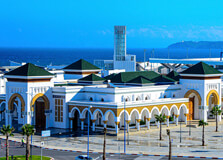
The Tangier Grand Mosque, also known as the "Mosquée de la Kasbah," is one of the most important religious and historical landmarks in Tangier, Morocco. Located in the heart of the city's Kasbah district, the mosque is an embodiment of the rich cultural and spiritual heritage of the region. With its elegant architecture, historical significance, and serene atmosphere, the Tangier Grand Mosque stands as a symbol of the city's deep-rooted Islamic traditions and offers visitors an opportunity to explore the religious heart of Tangier. How to Reach Tangier Grand Mosque, Tangier The Tangier Grand Mosque is conveniently located in the Kasbah, the old fortified part of Tangier, which is easily accessible from most areas in the city. Visitors can take a taxi to the Medina or the Kasbah and then enjoy a short walk through the narrow, winding streets leading up to the mosque. From the Tangier port or the central town area, the mosque is a 15 to 20-minute walk through the scenic and historic streets of the Kasbah. For those using public transport, the bus station in Tangier is about a 10-minute taxi ride away from the mosque. Alternatively, visitors can use the services of local taxis or shared ride services to get close to the mosque. Walking around the Kasbah is a beautiful experience as it offers a chance to admire the traditional Moroccan architecture, narrow streets, and vibrant local life. Weather in Tangier Grand Mosque The climate in Tangier is Mediterranean, with mild, wet winters and hot, dry summers. The best time to visit the Tangier Grand Mosque is during the spring (March to May) and autumn (September to November) months when temperatures range from 20°C to 25°C (68°F to 77°F). These months offer pleasant weather for exploring the Kasbah and the surrounding areas, making it ideal for tourists who prefer to avoid the extreme summer heat. Summers (June to August) can be warm, with temperatures reaching around 30°C (86°F), though the coastal breezes in Tangier help to keep the heat manageable. Winters (December to February) are mild, with temperatures generally ranging from 12°C to 18°C (54°F to 64°F), but there may be occasional rain. Regardless of the season, the weather in Tangier is typically comfortable for sightseeing. Timing for Visiting Tangier Grand Mosque The Tangier Grand Mosque is a functioning place of worship, and visitors are encouraged to visit during non-prayer hours. Typically, the mosque is open for visits throughout the day, except during the five daily prayer times, when it may be closed to tourists. It is advisable to plan your visit between 9:00 AM and 12:00 PM or after 2:00 PM to avoid overlapping with the prayer hours. It is important to note that the mosque is not a major tourist attraction like some other historical sites in Tangier, so it tends to be quieter. Visitors who are respectful of the mosque’s religious significance and cultural customs will be welcomed. Always check the opening times in advance, especially if you are visiting during Ramadan, as the timings might change. Why Tangier Grand Mosque is Famous The Tangier Grand Mosque holds significant religious and historical importance in the city. Its fame is primarily due to its location in the historic Kasbah district and its architectural beauty. The mosque has long been a place of worship for the people of Tangier and continues to serve as an important spiritual center for the local community. The mosque's traditional design and its role as a symbol of Islamic culture make it an essential landmark for visitors interested in Morocco's religious history. One of the unique features of the Tangier Grand Mosque is its position within the Kasbah, a district that was historically a stronghold of the region. This location allows visitors to explore the mosque alongside the historical walls and gates of the Kasbah, which has played a significant role in Tangier's development over centuries. Entry and Visit Details about Tangier Grand Mosque Unlike some larger mosques in Morocco, the Tangier Grand Mosque does not charge an entrance fee for visitors. However, it is important to remember that the mosque is primarily a religious site, and tourists should approach it with respect and decorum. Non-Muslim visitors are typically not allowed to enter the prayer hall, but they are welcome to enjoy the mosque’s outer areas, including the courtyard and its surroundings. If you wish to explore the mosque in more detail or learn about its history, you can consider hiring a local guide. The guides are often knowledgeable about the mosque’s history and architecture and can help you understand its significance in the context of Tangier’s broader cultural and historical narrative. In some cases, local guides may also be able to give you insight into the history of the Kasbah, which is closely tied to the mosque’s legacy. History and Architecture of Tangier Grand Mosque The history of the Tangier Grand Mosque dates back to the 17th century. It was originally built during the reign of the Alaouite Dynasty, which has ruled Morocco since the mid-17th century. The mosque's construction was part of a broader effort to establish Islamic institutions and maintain the religious practices of the local population in Tangier, which was a key city for trade, diplomacy, and culture. Architecturally, the Tangier Grand Mosque is a beautiful example of traditional Moroccan mosque design. Its structure features elegant whitewashed walls, a stunning prayer hall, and an open-air courtyard, which is typical of Moroccan mosques. The mosque’s design is characterized by intricate tilework, arches, and a large minaret that stands tall above the city, signaling its religious importance. The minaret is a key feature of the mosque, and like most mosques in Morocco, it was designed not just for religious purposes but also as a visual symbol of Islam in the city. The architecture of the Tangier Grand Mosque is typical of the late Islamic period, with a focus on symmetry, intricate geometric patterns, and the use of natural light in the prayer hall and courtyards. The building’s design reflects a fusion of Arab and Andalusian architectural styles, which were heavily influenced by Morocco’s cultural heritage. Things to Do at Tangier Grand Mosque Visiting the Tangier Grand Mosque is an opportunity to explore the spiritual heart of Tangier and experience the rich cultural heritage of Morocco. Here are a few things to do when visiting the mosque: Explore the Kasbah: The mosque is located within the Kasbah district, so visitors should take time to explore the narrow streets and alleys of this historic area. The Kasbah is full of charming architecture, local shops, and quiet corners that give a sense of Tangier’s past. Visit Nearby Historical Sites: While in the Kasbah, visitors can also explore other historic sites, such as the Tangier Kasbah Museum or the old gates and walls of the Kasbah, which offer insight into the city’s long history. Take Photos of the Architecture: Even though you may not be able to enter the prayer hall, the mosque’s exterior is stunning, and visitors can take photographs of the minaret, courtyard, and surrounding areas. The intricate tilework and architectural details make for fantastic photo opportunities. Learn About Local Islamic Culture: The mosque is a great place to learn more about the Islamic traditions and practices that are central to life in Morocco. Speaking with a local guide can offer insight into the customs and history of the mosque. Facts and Tips About Tangier Grand Mosque Fact: The Tangier Grand Mosque is one of the oldest and most significant mosques in the city and is an essential part of Tangier’s religious and cultural identity. Tip: Be respectful when visiting the mosque. Dress modestly, and avoid disturbing the worshippers during prayer times. If you are not Muslim, it is recommended to admire the mosque from the outside. Fact: The mosque’s minaret stands at 28 meters tall and is visible from many parts of Tangier, making it a significant landmark in the city. Tip: Visiting the mosque during prayer times can offer a unique experience, but be mindful of the local customs and the quiet atmosphere during these periods. Conclusion The Tangier Grand Mosque is a key piece of Tangier's historical and spiritual landscape. With its rich history, beautiful architecture, and peaceful atmosphere, it offers a unique experience for visitors. Whether you are exploring the Kasbah district or simply seeking to learn about the Islamic heritage of Morocco, a visit to the Tangier Grand Mosque is an essential part of any trip to Tangier.
Explore More